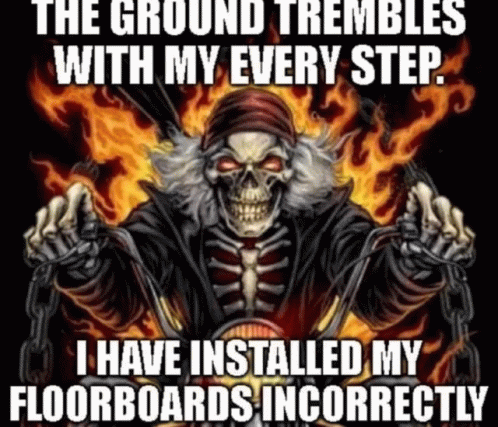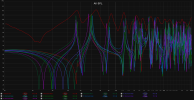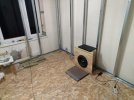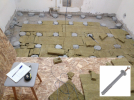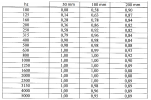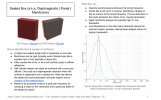Hello, I'm doing some renovations in my home theatre room. Basically i want to soundproof room from neighbors. I live in apartment.
Recently finished floating floor. But whenever i walk on it i hear a loud booming sound. And i personally don't mind it, but it will affect sound.

Floor consists of several layers:
1) Crooked concrete floor
2) Soft concrete heaps with insulation in-between.
3) OSB nailed down to heaps.
4) 10cm of insulation. Insulation is specifically designed for floating floors. Its density is about 115kg/m3.
5) 2 layers of OSB. Total heigh is 24 mm.
I've brought some subwoofer and measured it on this floor.
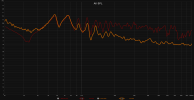 Red is subwoofer sine sweep. Orange is me stomping on the floor. They are practically the same. I think this means that subwoofer excite floor, but when subwoofer comes to a halt almost instantly, floor continues to play that frequency for some time.
Red is subwoofer sine sweep. Orange is me stomping on the floor. They are practically the same. I think this means that subwoofer excite floor, but when subwoofer comes to a halt almost instantly, floor continues to play that frequency for some time.
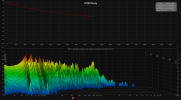 Decay is very bad. When i stop subwoofer playing specific frequency i still hear this decaying sound for about a second.
Decay is very bad. When i stop subwoofer playing specific frequency i still hear this decaying sound for about a second.
I thought about some EQ. Here is result:
 While things definitely became better, still there are some decay. And it doesn't solve the root of the problem, floor. At least, i think it is floor, but with bare concrete walls and ceiling... i don't know.
While things definitely became better, still there are some decay. And it doesn't solve the root of the problem, floor. At least, i think it is floor, but with bare concrete walls and ceiling... i don't know.
So, with all that in mind i have some questions.
There will be a lot of mass near walls in finished renovation.
1) Will adding more mass to the floor improve the situation?
I'm planning on making walls and ceiling from this same OSB. But unlike floating floor they will be fixed to metallic profiles.
2) Will walls and ceiling also vibrate/resonate and add decay?
I'd really preferred to keep this floor since its doing its job of isolation perfectly. Subwoofer is blasting on floating floor and there are absolutely no vibrations in the rest of apartment.
3) Theoretically, will different type of floating floor will be better for decay times?
I'm thinking about something like rubber joist isolators for wooden planks*. But i think they are way less effective isolators than insulation.
4) Any way to improve situation with this floor?
5) Is floor even at fault here?
I have bare concrete walls and ceiling, maybe they amplifying sound from floor...
6) Will fully treated room be free of this problem to some extent?
7) Should i even worry?
I have some measurements from this same room before starting renovations. Fully treated.
 It still had some decay, but i was totally fine with it.
It still had some decay, but i was totally fine with it.
Then again, this is with concrete walls and hard fixed wooden floor.
Also, observation.
I tried stomping on... ceramic? tile on concrete screed floor. I could barely hear any booming sound at all. But the measurement is somewhat really close to the new floating floor:
Maybe questions are not in the right order... but anyway, i think that's all. Any help/advice/sorting out will be appreciated.
Recently finished floating floor. But whenever i walk on it i hear a loud booming sound. And i personally don't mind it, but it will affect sound.

Floor consists of several layers:
1) Crooked concrete floor
2) Soft concrete heaps with insulation in-between.
3) OSB nailed down to heaps.
4) 10cm of insulation. Insulation is specifically designed for floating floors. Its density is about 115kg/m3.
5) 2 layers of OSB. Total heigh is 24 mm.
I've brought some subwoofer and measured it on this floor.
 Red is subwoofer sine sweep. Orange is me stomping on the floor. They are practically the same. I think this means that subwoofer excite floor, but when subwoofer comes to a halt almost instantly, floor continues to play that frequency for some time.
Red is subwoofer sine sweep. Orange is me stomping on the floor. They are practically the same. I think this means that subwoofer excite floor, but when subwoofer comes to a halt almost instantly, floor continues to play that frequency for some time. Decay is very bad. When i stop subwoofer playing specific frequency i still hear this decaying sound for about a second.
Decay is very bad. When i stop subwoofer playing specific frequency i still hear this decaying sound for about a second.I thought about some EQ. Here is result:
 While things definitely became better, still there are some decay. And it doesn't solve the root of the problem, floor. At least, i think it is floor, but with bare concrete walls and ceiling... i don't know.
While things definitely became better, still there are some decay. And it doesn't solve the root of the problem, floor. At least, i think it is floor, but with bare concrete walls and ceiling... i don't know.So, with all that in mind i have some questions.
There will be a lot of mass near walls in finished renovation.
1) Will adding more mass to the floor improve the situation?
I'm planning on making walls and ceiling from this same OSB. But unlike floating floor they will be fixed to metallic profiles.
2) Will walls and ceiling also vibrate/resonate and add decay?
I'd really preferred to keep this floor since its doing its job of isolation perfectly. Subwoofer is blasting on floating floor and there are absolutely no vibrations in the rest of apartment.
3) Theoretically, will different type of floating floor will be better for decay times?
I'm thinking about something like rubber joist isolators for wooden planks*. But i think they are way less effective isolators than insulation.
4) Any way to improve situation with this floor?
5) Is floor even at fault here?
I have bare concrete walls and ceiling, maybe they amplifying sound from floor...
6) Will fully treated room be free of this problem to some extent?
7) Should i even worry?
I have some measurements from this same room before starting renovations. Fully treated.
 It still had some decay, but i was totally fine with it.
It still had some decay, but i was totally fine with it.Then again, this is with concrete walls and hard fixed wooden floor.
Also, observation.
I tried stomping on... ceramic? tile on concrete screed floor. I could barely hear any booming sound at all. But the measurement is somewhat really close to the new floating floor:

Maybe questions are not in the right order... but anyway, i think that's all. Any help/advice/sorting out will be appreciated.

